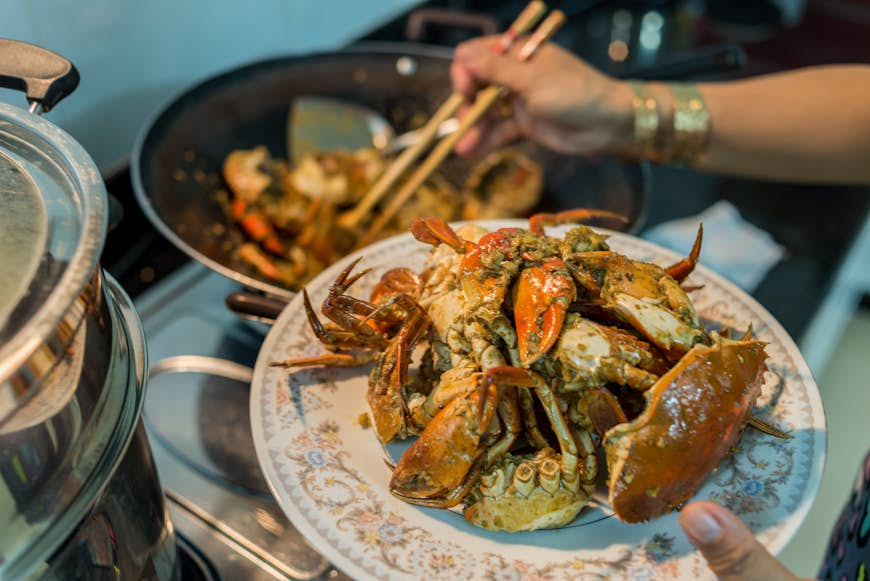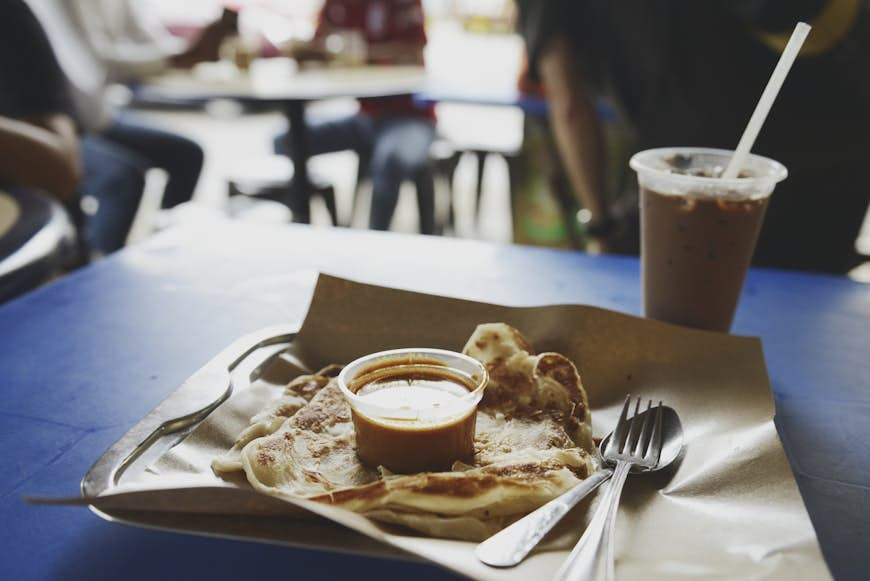
Compact Singapore may take less than an hour to drive across on a good day, but it has a wealth of tasty food options that reflect the diverse cultures that have come to call this island home. These original recipes were introduced by the early migrants bringing a piece of their roots with them. They have been remixed into uniquely Singaporean dishes that leave visitors hungry for more, even after returning home.
You can find food gems in just about any neighborhood here, and there’s an eatery for every type of traveler and budget. Cheap street food favorites can be found in the ubiquitous hawker centers – so key to Singapore’s identity that they’ve been awarded Unesco Intangible Heritage status. Shell out for a bit of finery at the growing list of award-winning upscale establishments, seek out a family eatery with no signboard that reviewers rave about, or fill your Instagram feed at a hip cafe with lines out the door.
Get local insight on destinations all over the world with our weekly newsletter delivered to your inbox.
Eating Singaporean food is essential to any Singaporean itinerary, but narrowing down a list of must-eat food is akin to choosing your favorite child and will likely start some online comment wars; Singaporeans are extra spirited when debating over the best and most authentic recommendations. Bring an empty stomach and an open mind: here’s our attempt at sharing some of Singapore’s most popular foods and how and where to eat them.
Contemplate the best Hainanese chicken rice
What’s so special about chicken and rice? Adapted from a Hainanese dish called Wenchang Chicken, the chicken is poached, sliced and served lukewarm – don’t skip out on the gelatinous skin, which is one of the highlights of the dish; get the roasted chicken version if you prefer a crispy skin. The fragrant rice is tasty enough to be a meal in itself. Garnish with some slices of cucumber and top it off with your preferred ratio of dark soy sauce and what some swear to be the most important element: spicy and tangy garlic chili sauce.
Where to try it: Tian Tian Hainanese Chicken Rice at Maxwell Food Centre in Chinatown is arguably the most famous hawker center stall; it beat celebrity chef Gordon Ramsay’s version some years back in a chicken rice showdown. Pow Sing, Nam Kee and Boon Tong Kee are some established restaurants where you can eat chicken rice alongside other Chinese home-cooked style zi char dishes in a more comfortable setting.
 Nothing beats a messy plate of chili crabs © SamuelBrownNG / Getty Images
Nothing beats a messy plate of chili crabs © SamuelBrownNG / Getty Images
Crack open some black pepper or chili crabs
Put on your bibs – it’s going to get messy when you crack open some chili crabs, a dish so famous that it’s been nicknamed Singapore’s National Dish. Deep-fried hard-shelled mud crabs are drenched in a thick starchy orange gravy that’s somehow sweet, savory, sour and spicy all at once. The best part of the meal is mopping up all that sumptuous sauce with some fried or steamed mantou bread buns.
If chili is not to your taste, black pepper crab is another Singaporean crab creation worth trying. Other popular crab dishes include white pepper crab, salted egg crab, and claypot crab soup with thick white beehoon noodles.
Where to try it: Roland Restaurant in Marine Parade is credited with creating chili crab in the 1950s. Black pepper crab was first created in 1962 by Long Beach Seafood – the UDMC outlet at East Coast Park has the best ambiance by the sea. For more convenient locations, Jumbo Seafood can be found on Orchard Road, downtown, and at Changi Airport.
Fish head curry
Fish head curry is another uniquely Singaporean fusion dish, the result of an Indian chef’s attempt to attract a Chinese audience. He dunked a big ikan merah (red snapper) fish head into his spicy Kerala-style curry with some vegetables. The result is a delicious dish loved by all, copied by many, and sold in both Chinese and Indian restaurants today. Don’t be put off by the bulging fish eyes – aficionados claim that the eyeball is one of the tastiest parts of the fish head, though most will agree that the cheek meat is the most tender.
Where to try it: Samy’s Curry on Dempsey Hill is a long-standing establishment where you can eat South Indian food on banana leaves; their fish head curry is thicker and typical of South Indian food. Na Na Curry, run by a Peranakan family, has several outlets and curry options, and their sourish Asam-style fish head curry is their bestseller.
 Spicy Nasi Padang is often shared family-style © Carlina Teteris / Getty Images
Spicy Nasi Padang is often shared family-style © Carlina Teteris / Getty Images
Feast on sumptuous Nasi Padang
Nasi means rice in Malay, and Padang is the Indonesian city where the Minangkabau, some of Singapore’s early Malay settlers, hailed from. Expect lots of lemak (coconut milk) and the fiery kick of chilies and spices in their cuisine – popular Nasi Padang dishes include braised beef rendang covered in a thick, pasty gravy and the spicy sambal goreng, a stir-fried dish of tofu, tempeh (fermented soybean) and green beans with a whole bunch of spices.
Nasi Padang is eaten either by selecting from multiple dishes behind a display counter to add to your plate of rice or as hidang, where multiple plates of food are served and shared at your table family-style. Utensils are provided, but the customary way is to eat using your right hand.
Where to try it: One of the first Malay communities in Singapore is Kampong Gelam, and it’s home to two well-known Nasi Padang restaurants perpetually thronged with crowds: Sari Ratu on Pahang Street and Hajjah (HJH) Maimunah at Jalan Pisang. For a wider variety of Malay food in Singapore, head to Geylang Serai Market or Haig Road Food Centre in the east.
Tuck into a traditional breakfast set
What Singaporeans call the “traditional” breakfast set was created by Hainanese immigrants who played a significant role in the early food scene and kopitiams (coffee shops). The set consists of toasted bread slathered with coconut jam or kaya and a slice of butter, a pair of soft-boiled eggs that you crack open into a small saucer, season with a little soy sauce and pepper and slurp up, and completed with a steaming cup of local-style kopi (coffee) or teh (tea). There is an entire lingo to customize your order with sugar, condensed milk, concentrated or just on its own.
Where to try it: The breakfast set is usually sold by the drink stalls in coffee shops only in the morning, but you can eat it any time of day at Ya Kun Kaya Toast and Killiney Kopitiam – well-known franchises with several decades of history and outlets all over Singapore and the world. Check out their original outlets at China Street and Killiney Road, respectively.
 Nyonya Laksa is known for its rich broth and spicy flavor © Jit Lim / Alamy Stock Photo
Nyonya Laksa is known for its rich broth and spicy flavor © Jit Lim / Alamy Stock Photo
Slurp up some spicy Nyonya laksa
Nyonya laksa is a real hodgepodge of influences thanks to its creators, the Peranakans. Born from the intermarriage between local-born Malays and early Chinese and Indian migrants, their rich traditions draw from a blend of these cultures. Nyonya laksa consists of white rice noodles soaked in lemak coconut milk-based broth flavored with a strong rempah (spice paste), made from a cocktail of spices and ingredients hand-pounded together. It’s all topped off with seafood like prawns and cockles. The noodles are usually trimmed short and eaten with just a soup spoon.
Where to try it: Nyonya Laksa is often called Katong Laksa, the name of the famous Peranakan enclave in eastern Singapore where you can find some of the best Peranakan food. Every laksa store there claims to be the original Katong Laksa; you can decide between 328 Katong Laksa and Janggut Laksa. Alternatively, Sungei Road Laksa at Jalan Berseh is where you can get a rare bowl of laksa cooked over a charcoal fire.
Skip the Singapore Sling for locally inspired cocktails
No doubt, sipping on a glass of the Singapore Sling at the iconic Raffles Hotel Long Bar while tossing your peanut shells on the floor is de rigeur on most Singaporean itineraries. But the local cocktail scene has grown exponentially over the last decade, with many bars and mixologists earning international accolades for creating clever concoctions inspired by local flavors. From hidden speakeasies that require a password for entry to sky-high hotel bars overlooking the city skyline, venture out into the night to properly experience what Singapore’s nightlife has to offer.
Where to try it: Nutmeg & Clove on Purvis Street does a great series of cocktails adapting classic cocktails with more Asian flavors like black plum vinegar and green barley. Origin Bar at the Shangri-La Hotel has cocktails inspired by local heritage neighborhoods like Chinatown and Orchard. Bar Stories in Kampong Gelam offers bespoke cocktails that a bartender whips up based on your preferences.
 Traditionally an Indian flatbread, roti prata is often served with creative sweet and savory toppings in Singapore © Carlina Teteris / Getty Images
Traditionally an Indian flatbread, roti prata is often served with creative sweet and savory toppings in Singapore © Carlina Teteris / Getty Images
Pig out on plates of roti prata
Indians are known for their flatbreads, but the one Singapore has truly embraced is roti prata. A little crispy outside and slightly chewy inside, kosong prata in its most basic form is dough that is hand-kneaded, stretched and fried on a griddle greased with ghee (clarified butter). Dip it into curry or sugar for a little extra flavor.
Prata shops in Singapore have gotten quite creative. Beyond standard egg and onions, you can now find ingredients like cheese and mushrooms or sweet versions with chocolate and ice cream on the menu. Try ordering a “plaster,” where the egg is cooked on top of the prata, or “tissue/paper,” where the dough is stretched super-thin and shaped into an extra crispy cone.
Where to try it: Roti prata can be eaten any time of day, though it is most popular for breakfast and supper as it is one of the few types of restaurants that stays open till late. Mr and Mrs Moghan’s is a tiny prata shop along Joo Chiat Road that’s a local favorite. If you’re looking for a broader range of wilder flavor options, try Casuarina Curry at Casuarina Road or any Springleaf Prata Place outlet.
Vegetarians and Vegans
It’s not difficult to be a vegetarian in Singapore. Plant-based and meat-free diets are growing in popularity. You can find meatless options, like Impossible Foods or Quorn, on menus alongside the animal meat options in many restaurants. In larger hawker centers and food courts, there is usually at least one vegetarian stall and fruit stall, while shopping malls typically have a salad shop as well.
Vegetarianism has always been a part of Singapore’s food scene due to the significant presence of religions like Buddhism, Taoism and Hinduism, in which some practitioners abstain from meat and allium. Fortune Centre at Bencoolen Street has a larger-than-usual selection of affordable vegetarian eateries in its midst due to its proximity to Kwan Im Thong Hood Cho Temple and Sri Krishnan Temple. Little India, with its plethora of north and south Indian restaurants, also has plenty of delicious Indian vegetarian options.
Where to try it: Whole Earth on Peck Seah Street is a multiple Michelin Bib Gourmand recipient where you can find Thai and Peranakan dishes – you won’t notice the missing meat from their Nonya curry. Warung Ijo along Beach Road is an Indonesian restaurant that offers local favorites like Nasi Padang and Lontong in vegetarian and vegan forms. If you’re into a raw food diet, check out The Living Cafe in Bukit Timah.
Foods worth trying
Durian: the eye-wateringly pungent King of Fruits can be pretty intimidating, but crack open its spiky shell and be rewarded with a creamy, slightly bitter flesh that’s quite unlike any other fruit. It can be eaten throughout the year but is most abundant and cheapest when in season from June to August. Pick an open-air location to eat, as the durian’s lingering stench has it banned from public transport and hotel rooms.
Ice cream sandwich: the only hawker you’ll see on Singapore’s street corners these days is the ice cream man, usually found at major road junctions in Orchard Road or downtown. This local dessert is a chunk of ice cream sliced off from a larger block and wedged between some rainbow-colored bread or two flimsy wafers. Eat it quickly, as it starts melting almost instantaneously.
Kueh: Kuehs are colorful, traditional bite-sized snacks that can be savory or sweet. Usually made from glutinous rice and flavors like pandan, gula melaka (palm sugar), coconut shavings and mung bean. Kuehs can come from the Chinese, Malay or Peranakans. Popular kuehs include Kueh Salat (two-layered glutinous rice + pandan coconut custard), Ang Ku Kueh (turtle-shell-shaped glutinous rice dough filled with peanut or bean paste) and Ondeh ondeh (a ball of pandan wrapped around gula melaka and rolled in coconut shavings).



